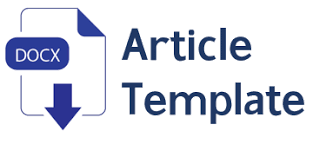The Relationship Between Perfectionism and Non-Suicidal Self Injury Incidents Among Nursing Students
Downloads
Students with perfectionistm personalities tend to always want to look perfect, so they are at high risk of experiencing despair, shame, anger, and depression. This condition often triggers Non-Suicidal Self Injury (NSSI) behavior as a way to vent or suppress emotions, which can cause body damage and the risk of infection. This study aims to analyze the Relationship between Perfectionist Personality and NSSI Incidents in Nursing Undergraduate Students.
This study uses a cross-sectional approach. The population of this study were 160 undergraduate nursing students at Semester 7. The sample obtained 115 respondents using proportionate stratified. Data collection used the Hewitt and Flett Multidimensional Perfectionism Scale and the Inventory of Statements About Self Injury. Data analysis used the Spearman test with a significance level of α = 0.01.
The results of the study were obtained from 115 respondents, almost half of which 40 (34.8%) respondents had a very high perfectionism personality, and almost half of which 55 (47.8%) respondents had very low Non-Suicidal Self Injury behavior. Based on the results of the Spearman test, the value of ρ = 0.000 was obtained, which means that there is a relationship between Perfectionism Personality and Non-Suicidal Self Injury Incidents among nursing students.
The high level of perfectionism in nursing students, accompanied by low levels of NSSI, indicates that most of them have adaptive behavioral patterns. This means that even though they tend to be perfectionists, they are able to manage stress without engaging in destructive behavior. It is expected that the University will strengthen the counseling or campus psychologist services by holding regular counseling sessions that are scheduled regularly. This can help students cope with stress, anxiety, and other mental health issues, including preventing perfectionism personality and NSSI behavior.
Lipinski, D., Matuszyk, E., Sarlak, H., Steedman, E, Lazuras, L, 2020. Prevalence And Psychiatric Correlates Of Suicidal Ideation In UK University Students. J. Affect. Disord. 272, 191–197.
Al Farisi, S. Y., Arpandy, G. A., & Fitriah, A. (2024). Hubungan Antara Fear Of Failure Dengan Perfeksionisme Pada Mahasiswa. Jurnal Psikologi, 1(4), 19-19.
Alitani, M. B. (2023). Self-Compassion Pada Mahasiswa Yang Pernah Mengalami Perundungan. Jurnal Cahaya Mandalika ISSN 2721-4796 (online), 4, 21-25.
Amelia, F. (2022). Kecemasan Dalam Perspektif Rational Emotive Behaviour Therapy Albert Ellis (Doctoral Dissertation, Universitas Islam Negeri Sultan Syarif Kasim Riau).
Devi, S. T. (2023). Gambaran Regulasi Emosi Pada Mahasiswa Pelaku Self Injury (Doctoral Dissertation, Uin Sunan Kalijaga Yogyakarta).
Diah, D. N., Lubis, F. Y., & Witriani, W. (2020). Efek moderasi resiliensi terhadap hubungan antara perfeksionisme dengan kecemasan mengerjakan skripsi. Gadjah Mada Journal of Psychology (GamaJoP), 6(2).
Endarwita, E. (2021). Peran Pendidikan Kewirausahaan Dan Kepribadian Terhadap Minat Berwirausaha Pada Mahasiswa Sekolah Tinggi Ilmu Ekonomi Pasaman. Jurnal Ilmiah Edunomika, 5(02), 466833.
Epivania, V., & Soetjiningsih, C. H. (2023). Kematangan emosi dan perilaku melukai diri pada mahasiswa. Jurnal Inovasi Penelitian, 3(8), 7337-7344.
Fahira, S. V., Santi, D. E., & Ananta, A. (2023). Kecenderungan Non-Suicidal Self- Injury Pada Remaja: Bagaimanakah Peranan Kesepian Dan Life Satisfaction?. INNER: Journal Of Psychological Research, 2(4), 588-593.
Fatmasari, (2019). Buku Ajar Psikologi Kepribadian Lanjut: Jilid 1. Undip Press Semarang.
Fathiawati, A. S., & Sawitri, D. R. (2020). Hubungan Antara Perfeksionisme Dan Music Performance Anxiety Pada Mahasiswa Pemain Orkestra. Jurnal Empati, 10(2), 94-100.
Grant, J.B., Batterham, P.J., Mccallum, S.M., Werner-Seidler, A., Calear, A.L., 2023. Specific Anxiety And Depression Symptoms Are Risk Factors For The Onset Of Suicidal Ideation And Suicide Attempts In Youth. J. Affect. Disord. 327, 299–305.
Hanan, A. F., Kusmawati, A., Putri, T. E., & Oktaviani, T. (2024). Pentingnya Dukungan Sosial Terhadap Perilaku Self-Harm Pada Remaja Yang Merasa Kesepian. Concept: Journal Of Social Humanities And Education, 3(1), 211-218
Nurmaidah, S. (2023). Hubungan Antara Perfeksionisme Dengan Prokrastinasi Akademik Pada Mahasiswa Akhir Yang Sedang Menyusun Skripsi Di Fakultas Dakwah Universitas Islam Negeri Kiai Haji Achmad Siddiq Jember. Skripsi Uin Khas Jember, 72-78.
Oksatianti, G. K. (2021). Hubungan Regulasi Emosi Dan Perilaku Non-Suicidal Self-Injury Pada Remaja Skripsi (Doctoral Dissertation, Uin Sunan Kalijaga Yogyakarta).
Philantropic, J. S. (2022). Self Esteem Dengan Kecenderungan Self Injury Pada Mahasiswa Yang Mengalami Putus Cinta. Jurnal Social Philantropic, 1(2), 9-15.
Prihartini, E., & Abdullah, D. (2023). Analisis Faktor-Faktor Yang Mempengaruhi Keputusan Kuliah Di Perguruan Tinggi Swasta. Entrepreneur: Jurnal Bisnis Manajemen Dan Kewirausahaan, 4(1), 205-219.
Prof. Dr. Suryana, Ms. (2019). Metodologi Penelitian : Metodologi Penelitian Model Prakatis Penelitian Kuantitatif Dan Kualitatif. Universitas Pendidikan Indonesia, 1–243. Https://Doi.Org/10.1007/S13398-014-0173-7.2
Prihastuty, D. R. (2023). BAB VIII Sampling. Pengantar, 97.
Putri, F. N. S. (2021). Self-Injury Di Era Digital: Pengembangan Skala Self-Injury In The Digital Era: Scale Development. Prosiding Seminar Nasional Fakultas Psikologi Umby, 71.
Ramdhan, M. (2021). Metode Penelitian. Cipta Media Nusantara.
Reinhardt, M., Horv´Ath, Z., Drubina, B., Kok¨ Onyei, ¨ G., & Rice, K. G. (2021). Latent Class Analysis Of Nonsuicidal Self-Injury Among Justice-Involved Juveniles: Association With Motivational And Emotional Aspects Of Self- Harm Behavior. Criminal Justice And Behavior, 48(7), 902–922. Https://Doi.Org/10.1177/0093854821998411.
Rina, R. S., Nauli, F. A., & Indriati, G. (2021). Gambaran Perilaku Self Injury dan Risiko Bunuh Diri pada Mahasiswa. Health Care: Jurnal Kesehatan, 10(2), 305-312.
Rong, F., Wang, M., Peng, C., Cheng, J., Wang, Y., & Yu, Y. (2024). Specific And Cumulative Effects Of Childhood Maltreatment On Nonsuicidal Self-Injury In Chinese Adolescents: The Moderating Effect Of Sleep Disturbance. Child Abuse & Neglect, 149, 106627.
Rukmana, B. (2021). Faktor-Faktor Penyebab Terjadinya Perilaku Self Injury Pada Mahasiswa Yang Berkuliah Di Universitas Swasta Di Kota Pekanbaru (Doctoral Dissertation, Universitas Islam Riau).
Sari, I. N., & Lestari, S. (2023). Perfeksionisme Dan Manajemen Waktu Sebagai Prediktor Perilaku Prokrastinasi Akademik Pada Mahasiswa. Jurnal Psikogenesis, 11(1), 29-43.
Urme, S. A., Islam, M. S., Begum, H., & Chowdhury, N. R. A. (2022). Risk Factors Of Suicide Among Public University Students Of Bangladesh: A Qualitative Exploration.Heliyon,8(6), E09659.
Verenisa, A., & Sriati, S. A. (2021). Gambaran Self-Injury Mahasiswa. Jurnal Ilmu Keperawatan Jiwa, 4(1).
Whitlock, J., & Lloyd-Richardson, E. (2019). Healing Self-Injury: A Compassionate Guide For Parents And Other Loved Ones. Oxford University Press.
Widyaningrum, D. A., & Putri, M. A. (2024). Literatur Review: Faktor Yang Mempengaruhi Non Suicidal Self-Injury (Nssi) Pada Remaja. Jurnal Keperawatan Dirgahayu (JKD), 6(1), 56-62.
Younsil A. Lee, Haeyoung G. Park, Jeong Eun Cheon, Kenneth G. Rice, Young- Hoon Kim,Mediating Role Of Social Skills In The Longitudinal Relationship Between Intrapersonal Perfectionism And Psychological Well-Being Of Preadolescents,Journal Of Schoolpsychology,Volume102,2024,101257,ISSN00224405, Https://Doi.Org/10.1016/J.Jsp.2023.101257.
Zulfiana, U. (2020). Perfeksionisme dan subjective well-being pada mahasiswa organisasi kesenian. Psycho Holistic, 2(1), 152-166.

This work is licensed under a Creative Commons Attribution-NonCommercial-ShareAlike 4.0 International License.

In order to be accepted and published by Jurnal Promkes: The Indonesian Journal of Health Promotion and Health Education, Author(s) who submit an article should complete all the review process. The copyright of received articles assigned to the Jurnal Promkes: The Indonesian Journal of Health Promotion and Health Education,and Department of Health Promotion and Behavior Science, Universitas Airlangga as publishers of the journal. The intended copyright includes the rights to publish articles in various forms (including reprints).
Jurnal Promkes: The Indonesian Journal of Health Promotion and Health Education's website. Authors are allowed to use their works for any purposes deemed necessary without written permission from Jurnal Promkes: The Indonesian Journal of Health Promotion and Health EducationS and/or Department of Health Promotion and Behavior Science, Universitas Airlangga with an acknowledgement of initial publication in this journal.
The Editorial Team of Jurnal Promkes: The Indonesian Journal of Health Promotion and Health Education and Department of Health Promotion and Behavior Sciences strive to ensure that no errors occur in the articles that have been published, both data errors and statements in the article.
Users of this website will be licensed to use materials from this website following the Creative Commons Attribution-NonCommercial-ShareAlike 4.0 International License. No fees charged. Please use the materials accordingly.
------------------------------------------------------------------------------------------------------------------------------------------------------------------------------------------
Attribution ” You must give appropriate credit, provide a link to the license, and indicate if changes were made. You may do so in any reasonable manner, but not in any way that suggests the licensor endorses you or your use.
NonCommercial ” You may not use the material for commercial purposes.
ShareAlike ” If you remix, transform, or build upon the material, you must distribute your contributions under the same license as the original.


























